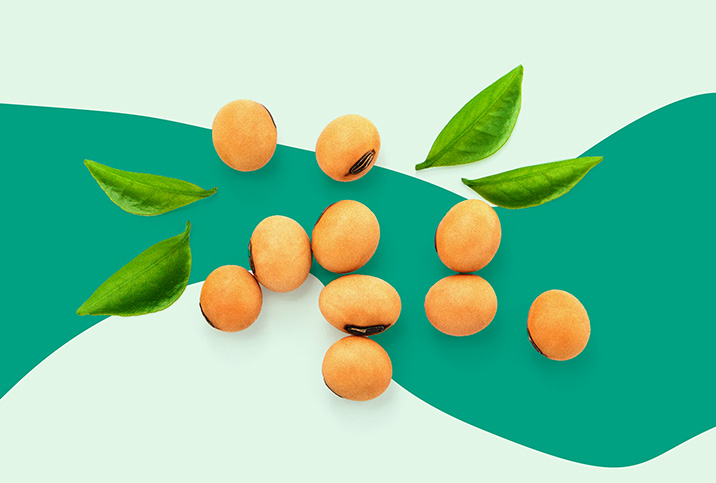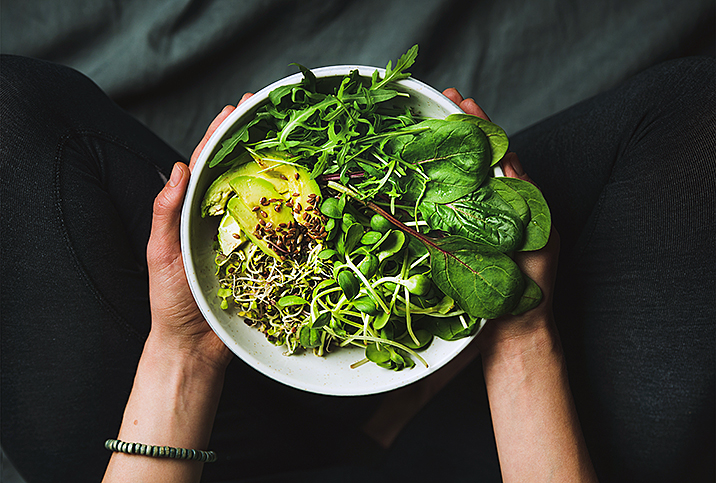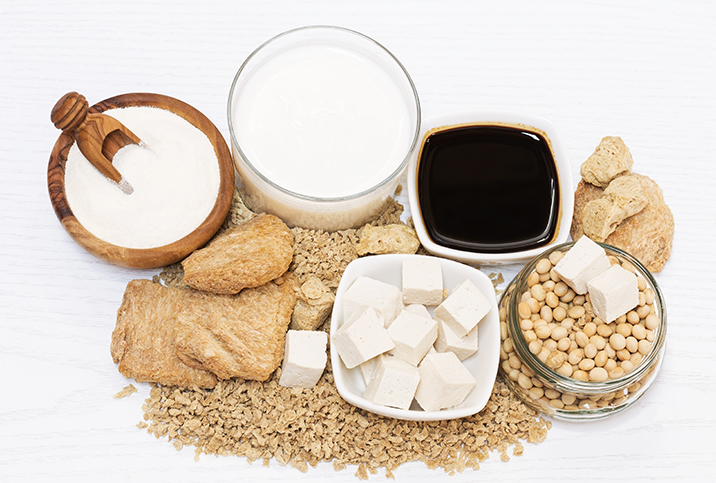The Truth About the Soy Estrogen Myth

Of all the concerns about hormonally engorged livestock and genetically modified vegetables, the concept of phytoandrogens and phytoestrogens remains fairly unnoticed in dietary debates.
"Phytohormones such as phytoestrogens and phytoandrogens are chemical compounds made by plants to regulate their reproduction, growth and ability to fight off bacterial infections," said Sheldon Zablow, M.D., an author and educator in San Diego. "Their structures are comparable to the human forms of estrogen and androgen [testosterone] and, therefore, can bind to the same hormone receptors on cells."
One aspect of the debate is the soy estrogen myth, or claims about soy's benefits and risks. Soy contains a high concentration of isoflavones, a type of phytoestrogen.
The origin story of phytoestrogens and health concerns begins with a flock of sheep and a pasture of red clover. Concerned farmers noticed herds of sheep grazing exclusively on red clover—an otherwise nutrient-rich food source—experienced infertility issues or higher rates of stillborn offspring. While the validity of the claim is debatable, this phenomenon was chalked up to the phytoestrogens present in the clover acting as a survival mechanism by limiting the reproduction of its natural predator, the sheep.
Overlooking that the clover contains different levels of phytohormones at different life stages and that it's unlikely humans have as homogenous a diet as sheep, some people worried that these infertility rates—if true—might extend to humans.
"When these plant-based compounds bind to human cells, they are called endocrine disruptors because they disrupt natural hormonal regulation by stimulating a response or by preventing a natural response from occurring," Zablow explained. "Many medical studies conclude ingesting foods high in phytohormones reduces estrogen and progesterone, while some research shows no change, meaning the science is not definitive."
Disruption sounds bad but can be good
Endocrine disruption sounds more negative than it actually is. Medicine such as birth control disrupts bodily functions but for an intended, medically prescribed purpose.
The actual process of endocrine disruption in the case of phytohormones involves estrogen receptors (ER), specifically ERα and ERβ. Phytoestrogens don't link strongly to ERα, which largely regulates the breast, uterus, cervix, vagina and other reproductive organs. Instead, they prefer ERβ, which is believed to be linked to the ovaries, prostate gland, testes, spleen, lungs, hypothalamus and thymus. This is theorized as the explanation behind the paradoxical effects of phytoestrogens, which are called estrogenic and anti-estrogenic at different points by different people.
We know foods richest in phytohormones are typically nuts, seeds and produce. Specifically, though, the phytoestrogen debate homes in on a naturally bland yet hotly controversial food. Tofu, made from soybean curds, is widely consumed by vegetarians and omnivores alike, especially in Asian countries. Asia hosts 60 percent of the total human population but only 39 percent of all breast cancer cases. Such cancer rates call tofu's phytoestrogen content into question. In premenopausal women, who have higher circulating levels of the major estrogen form estradiol, soy products like tofu may act like an anti-estrogen; in postmenopausal women who have less circulating estradiol, soy can act in just the opposite way, as an estrogen mimic.
Such variability makes phytoestrogens' role in hormone balance and associated health problems difficult to determine.
Rules of application—or nonapplication
Estradiol, one of the four subsets of estrogen and considered the strongest, is most common in nonpregnant women. Elemental to puberty and reproductive health, estradiol possesses side effects if too high, including acne, depression and, in severe cases, cardiovascular disease and hormone-based cancers. Without it, brain function is compromised and osteoporosis becomes more likely. Thus, balance is critical.
Phytoestrogens aren't as powerful as estradiol, but the interplay between the two is essential and varies considering a person's life stage and health goals. For people who perceive their circulating estradiol as too high, the potential anti-estrogen effects of phytoestrogens may sound ideal. However, taking your hormone levels into your own hands comes with a risk: Zablow warned that like all supplements in the United States, phytoestrogen tablets don't come with guarantees.
"The confidence consumers have that the person collecting, manufacturing, testing and importing supplements is following minimal U.S. health and safety guidelines might be misplaced," he explained.
If you and your doctor believe phytoestrogens could benefit you, it might be better to obtain them from foods that also bear additional health benefits, or ask a pharmacist, physician or dietitian about vetted supplement manufacturers.
While you may be on the fence about the hormonal contents of tofu, for example, its low-calorie, high-protein properties are irrefutable. Tofu is in good company. Fermented, non-GMO soy products (think tempeh and miso), as well as grains like oats, rice, barley and rice bran, sesame, flax or sunflower seeds, sunflower seeds, almonds and legumes (chickpeas, lentils, kidney beans and split peas), are all phytoestrogen-rich foods with a host of other health benefits.
Contributing or inhibiting?
The debate around phytoestrogen's role in helping or hindering hormone levels may never be settled. Claims of tofu spurring premature puberty, impacting fertility, inhibiting or fostering cancers, or even causing men to grow breasts can only be contextualized by understanding the affected person's specific hormonal state, life stage and unique health goals.
Amy Roskin, M.D., an OB-GYN based in Weston, Florida, summarized the benefits and potential risks of phytohormones for girls and women of all ages.
"A phytoestrogen-rich diet in women in their 20s and 30s, in limited studies, suggested acne might improve [but presented] concerning risks regarding effects on ovaries and fertility," she explained. "I would recommend preadolescent girls avoid a phytoestrogen-rich diet and any related supplements. There have been a few studies that indicated a disruption in the puberty process; generally, delayed puberty in girls."
The soy estrogen myth exists, in part, because of the intricacies of soy's effects on the body.
As females age, Roskin said: "Some women report that eating a phytoestrogen-rich diet leads to them experiencing fewer hot flashes and related symptoms during menopause. However, there is some concern that phytoestrogenic effects might increase the risks of cancer in hormone-sensitive organs."
Zablow added a caveat that extends to much of the debate around food, supplements and health.
"Just because a substance comes from a plant does not mean it is harmless, as many humans and animals have discovered after ingesting certain mushrooms, mistletoe, daffodils, foxglove, tulip bulbs, hemlock, etcetera," he said. "The benefit or harm of using phytohormones depends on many factors unique to each individual, such as the amount consumed, the purity of the extracts, preexisting health, age and the microbiome of the gut."
The soy estrogen myth exists, in part, because of the intricacies of soy's effects on the body. Diets high in tofu and soybeans, although common in certain parts of the world, are still relatively new as a mainstream food staple in Western diets, so more research data will likely be available in the future.
Ultimately, each human is their own microbiome, and the decision to use phytohormones should be weighed with the advice of a medical provider.




















